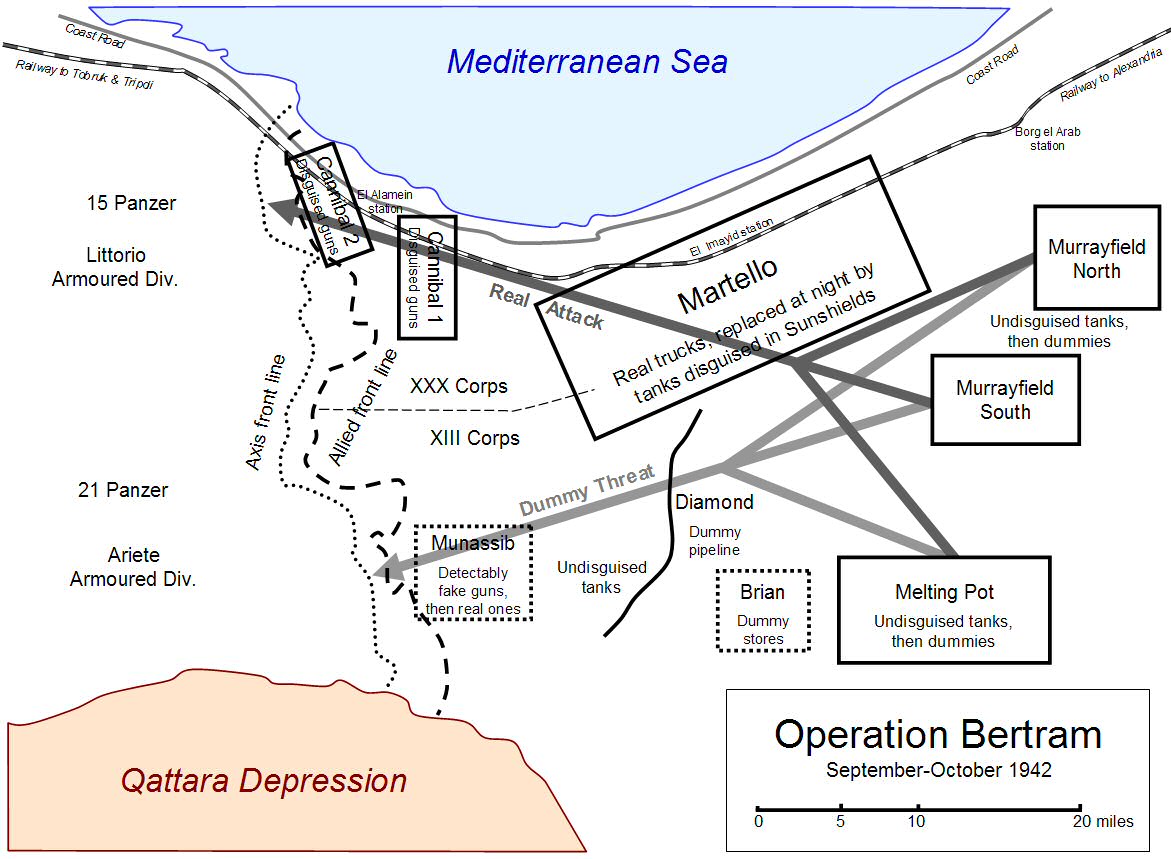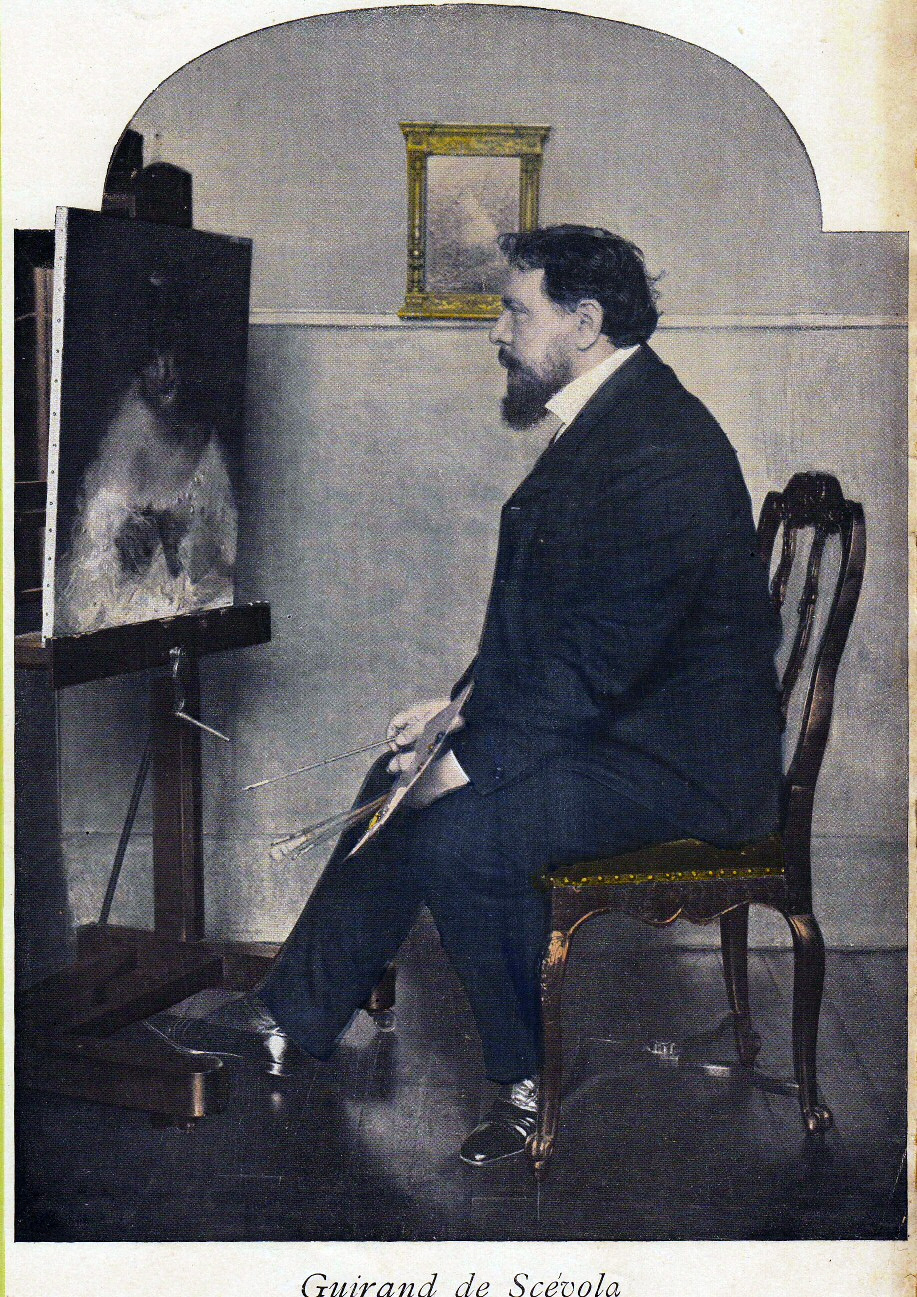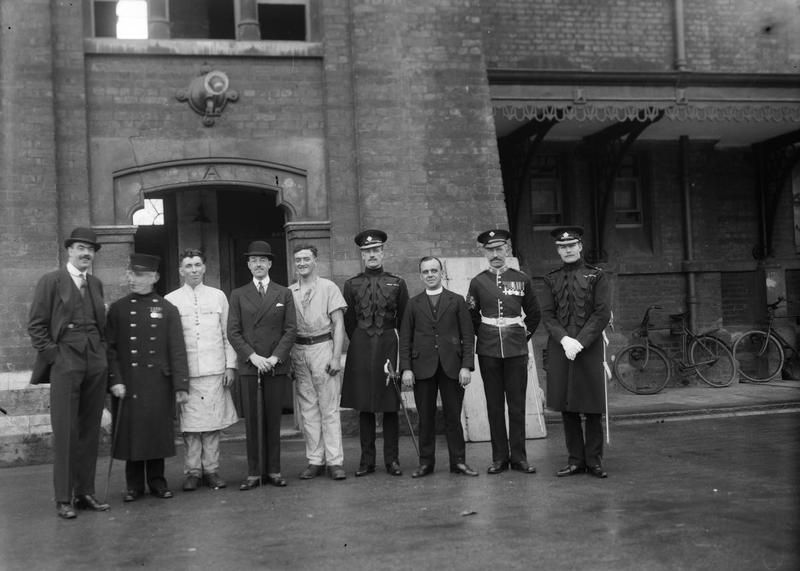|
Cannibal (camouflage)
Operation Bertram was a Second World War deception operation practised by the Allied forces in Egypt led by Bernard Montgomery, in the months before the Second Battle of El Alamein in 1942. Bertram was devised by Dudley Clarke to deceive Erwin Rommel about the timing and location of the Allied attack. The operation consisted of physical deceptions using dummies and camouflage, designed and made by the British Middle East Command Camouflage Directorate led by Geoffrey Barkas. These were accompanied by electromagnetic deceptions codenamed Operation Canwell, using false radio traffic. All of these were planned to make the Axis believe that the attack would take place to the south, far from the coast road and railway, about two days later than the real attack. Bertram consisted of the creation of the appearance of army units where none existed and in concealing armour, artillery and ''matériel''. Dummy tanks and guns were made mainly of local materials including calico and palm-fron ... [...More Info...] [...Related Items...] OR: [Wikipedia] [Google] [Baidu] |
Middle East Command Camouflage Directorate
The British Middle East Command Camouflage Directorate (also known as the Camouflage Unit or Camouflage Branch) organised major deception operations for Middle East Command in the Western Desert Campaign of the Second World War. It provided camouflage during the siege of Tobruk; a dummy railhead at Misheifa, and the largest of all, Operation Bertram, the army-scale deception for the decisive battle of El Alamein in October 1942. The successful deception was praised publicly by Winston Churchill. These operations contributed to victory by diverting enemy attention from real targets to dummy ones, wasting enemy ammunition, preserving vital resources such as the single water desalination plant at Tobruk, and deceiving the enemy as to allied strength and intentions. Operation Bertram may have been the last army-scale physical deception ever to take place, since subsequent major deceptions, including those for the D-Day landings in Normandy, have included or consisted of electronic me ... [...More Info...] [...Related Items...] OR: [Wikipedia] [Google] [Baidu] |
Map Of Operation Bertram
A map is a symbolic depiction emphasizing relationships between elements of some space, such as Physical body, objects, regions, or themes. Many maps are static, fixed to paper or some other durable medium, while others are dynamic or interactive. Although most commonly used to depict geography, maps may represent any space, real or fictional, without regard to Context (language use), context or Scale (map), scale, such as in brain mapping, DNA mapping, or computer network topology mapping. The space being mapped may be two dimensional, such as the surface of the earth, three dimensional, such as the interior of the earth, or even more abstract spaces of any dimension, such as arise in modeling phenomena having many independent variables. Although the earliest maps known are of the heavens, geographic maps of territory have a very long tradition and exist from ancient times. The word "map" comes from the , wherein ''mappa'' meant 'napkin' or 'cloth' and ''mundi'' 'the world'. ... [...More Info...] [...Related Items...] OR: [Wikipedia] [Google] [Baidu] |
Mauritius
Mauritius ( ; french: Maurice, link=no ; mfe, label=Mauritian Creole, Moris ), officially the Republic of Mauritius, is an island nation in the Indian Ocean about off the southeast coast of the African continent, east of Madagascar. It includes the main island (also called Mauritius), as well as Rodrigues, Agaléga and St. Brandon. The islands of Mauritius and Rodrigues, along with nearby Réunion (a French overseas department), are part of the Mascarene Islands. The main island of Mauritius, where most of the population is concentrated, hosts the capital and largest city, Port Louis. The country spans and has an exclusive economic zone covering . Arab sailors were the first to discover the uninhabited island, around 975, and they called it ''Dina Arobi''. The earliest discovery was in 1507 by Portuguese sailors, who otherwise took little interest in the islands. The Dutch took possession in 1598, establishing a succession of short-lived settlements over a period of about ... [...More Info...] [...Related Items...] OR: [Wikipedia] [Google] [Baidu] |
East Africa
East Africa, Eastern Africa, or East of Africa, is the eastern subregion of the African continent. In the United Nations Statistics Division scheme of geographic regions, 10-11-(16*) territories make up Eastern Africa: Due to the historical Omani Empire and colonial territories of the British East Africa Protectorate and German East Africa, the term ''East Africa'' is often (especially in the English language) used to specifically refer to the area now comprising the three countries of Kenya, Tanzania, and Uganda. However, this has never been the convention in many other languages, where the term generally had a wider, strictly geographic context and therefore typically included Djibouti, Eritrea, Ethiopia, and Somalia.Somaliland is not included in the United Nations geoscheme, as it is internationally recognized as a part of Somalia. *Tanzania, Kenya, Uganda, Rwanda, Burundi, Democratic Republic of Congo and South Sudan are members of the East African Community. The firs ... [...More Info...] [...Related Items...] OR: [Wikipedia] [Google] [Baidu] |
Brian Robb
Brian Robb (7 May 1913 – 1979) was a painter, illustrator, and cartoonist. He worked for Shell and London Transport, designing posters and advertisements, and as a cartoonist for Punch magazine. During the Second World War, he served as a camouflage officer in the Western Desert. He taught at Chelsea College of Art before and after the war, before becoming head of illustration at the Royal College of Art. Biography Early life Robb was educated at Malvern College. He studied at Chelsea School of Art from 1930, and at the Slade School of Fine Art from 1935.Stroud, 2012. p181. During the 1930s he became known for his humorous cartoons published in Punch. He was a skilled illustrator, creating both pen-and-ink and watercolour illustrations for books such as ''The Adventures of Odd and Elsewhere''. He was in demand for his ability to design posters for London Transport and advertisements for the Shell oil company, where he had worked for Jack Beddington. In 1937 he marrie ... [...More Info...] [...Related Items...] OR: [Wikipedia] [Google] [Baidu] |
Maxwell Ayrton
Ormrod Maxwell Ayrton FRIBA (1874 – 18 February 1960), known as Maxwell Ayrton, was an English architect. He spent most of his adult life working in London and designed houses, public buildings, and bridges. Early life Maxwell Ayrton was born in Chester to William Frances Ayrton, a wealthy wine-merchant who was a partner and co-founder of the firm of Ayrton & Groome, and his second wife Pauline. Two of Maxwell's full brothers also gained prominence. The eldest, William Ayrton (1861–1916), was an artist based in Suffolk. Randle Ayrton was a leading actor of stage and screen. The Ayrton family originated in Yorkshire. Maxwell's forebear Edward Ayrton was mayor of Ripon in 1760, and laid the foundations for the family's subsequent prominence. Career Ayrton began his career in 1890 as an articled apprentice to Harry Beswick of Chester, remaining with him until 1897. He then moved to London, where from 1897 to 1899 he was an assistant first to Richard Creed, then to Wil ... [...More Info...] [...Related Items...] OR: [Wikipedia] [Google] [Baidu] |
List Of Camoufleurs
A camoufleur or camouflage officer is a person who designed and implemented military camouflage in one of the world wars of the twentieth century. The term originally meant a person serving in a First World War French military camouflage unit. In the Second World War, the British camouflage officers of the Middle East Command Camouflage Directorate, led by Geoffrey Barkas in the Western Desert, called themselves ''camoufleurs'', and edited a humorous newsletter called ''The Fortnightly Fluer''. Such men were often professional artists. The term is used by extension for all First and Second World War camouflage specialists. Some of these pioneered camouflage techniques. This list is restricted to such notable pioneers of military camouflage. Surrealist artist Roland Penrose wrote that he and Julian Trevelyan were both "wondering how either of us could be of any use in an occupation so completely foreign to us both as fighting a war, we decided that perhaps our knowledge of pa ... [...More Info...] [...Related Items...] OR: [Wikipedia] [Google] [Baidu] |
Steven Sykes (artist)
Steven Barry Sykes (30 August 1914 – 22 January 1999) was a British artist, known for his Gethsemane Chapel in the rebuilt Coventry Cathedral. He was active in the British desert camouflage unit in the Second World War, and was responsible for the dummy railhead at Misheifa and for the effective camouflage and large-scale military deception in the defence of Tobruk in 1942. Early life Sykes was born in Formby, Lancashire. His father was a family doctor, A. B. Sykes of Ashhurst, Formby. He went to the Oratory School in Caversham, Berkshire and studied stained glass design at the Royal College of Art. He won a travel scholarship to France and Italy in 1936 and on his return he joined Herbert Hendrie's stained glass studio in Edinburgh. Sykes married artist Jean Judd in February 1940. At his death in 1999, he left two sons and a daughter. World War II camouflage Sykes's RCA tutor, Barry Hart, who knew Freddie Beddington, founder of the Camouflage Development and Training Centr ... [...More Info...] [...Related Items...] OR: [Wikipedia] [Google] [Baidu] |
Jasper Maskelyne
Jasper Maskelyne (29 September 1902 – 15 March 1973) was a British stage magician in the 1930s and 1940s. He was one of an established family of stage magicians, the son of Nevil Maskelyne and a grandson of John Nevil Maskelyne. He is most remembered for his accounts of his work for the British military during the Second World War, in which he claimed to have created large-scale ruses, deception, and camouflage in an effort to defeat the Nazis. Early life Maskelyne was born in Wandsworth, London, England in 1902, to magician Nevil Maskelyne and his wife Ada Mary Ardley. Career Stage magician Maskelyne was a successful stage magician. His 1936 ''Maskelyne's Book of Magic'' describes a range of stage tricks, including sleight of hand, card and rope tricks, and illusions of "mind-reading". In 1937, Maskelyne appeared in a Pathé film, ''The Famous Illusionist'', in which he performed his well-known trick of appearing to swallow razor blades. Wartime service Maskelyne jo ... [...More Info...] [...Related Items...] OR: [Wikipedia] [Google] [Baidu] |
Tony Ayrton
Antony Maxwell Ayrton (1909 – 4 April 1943) known as Tony Ayrton, was an artist and Camoufleurs, camouflage officer. He is best known for his work on the large-scale Military deception, deception for the decisive second battle of El Alamein, Operation Bertram. Early life Ayrton was born in 1909 into a creative family of some merit. His father, perhaps the most conventional, was the architect Maxwell Ayrton; one uncle was the actor Randle Ayrton, while another was the artist William Ayrton. Tony himself became an artist.: ''Alpine Landscape''. This work contains a signature lower right "Antony Ayrton". The Ayrton family originated in Yorkshire, though Tony descended from a branch long-resident in Cheshire. His forebear Edmund Ayrton#the Ayrton family, Edward Ayrton was mayor of Ripon in 1760, and laid the foundations for the family's subsequent prominence. War service Ayrton was gazetted an officer in the Royal Engineers, on 3 December 1939. He was responsible for forming N ... [...More Info...] [...Related Items...] OR: [Wikipedia] [Google] [Baidu] |
Freddie De Guingand
Major-General Sir Francis Wilfred "Freddie" de Guingand, (28 February 1900 – 29 June 1979) was a British Army officer who served as Field Marshal Sir Bernard Montgomery's chief of staff from the Second Battle of El Alamein until the end of the Second World War. He played an important diplomatic role in sustaining relations between the notoriously difficult Montgomery and his peers and superiors. A graduate of the Royal Military College, Sandhurst, de Guingand joined the West Yorkshire Regiment (Prince of Wales's Own) in December 1919. He served in India and Ireland, and was seconded to the King's African Rifles in Nyasaland from 1926 to 1931. Through the intervention of Montgomery, with whom he had formed a friendship with during their service together the 1920s and 1930s, he secured a nomination to 1935–36 course at the Staff College, Camberley. He served as Military Assistant to the Secretary of State for War, Leslie Hore-Belisha, from 1939 to 1940, in which role he ha ... [...More Info...] [...Related Items...] OR: [Wikipedia] [Google] [Baidu] |
Harold Alexander
Harold Rupert Leofric George Alexander, 1st Earl Alexander of Tunis, (10 December 1891 – 16 June 1969) was a senior British Army officer who served with distinction in both the First and the Second World War and, afterwards, as Governor General of Canada and the first Lord Lieutenant of Greater London in 1965. Alexander was born in London to aristocratic parents, and was educated at Harrow before moving on to the Royal Military College, Sandhurst, for training as an army officer of the Irish Guards. He rose to prominence through his service in the First World War, receiving numerous honours and decorations, and continued his military career through various British campaigns across Europe and Asia. In the Second World War, Alexander oversaw the final stages of the Allied evacuation from Dunkirk and subsequently held high-ranking field commands in Burma, North Africa and Italy, including serving as Commander-in-Chief Middle East and commanding the 18th Army Group in Tunisi ... [...More Info...] [...Related Items...] OR: [Wikipedia] [Google] [Baidu] |









